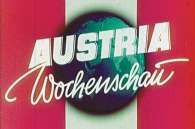 >> View collection On the European Film Gateway, the Filmarchiv Austria presents clips from the "Austria Wochenschau" (1949 – 1994), a newsreel collection which forms today a substantial starting point for Austria’s documented audiovisual contemporary history.
>> View collection On the European Film Gateway, the Filmarchiv Austria presents clips from the "Austria Wochenschau" (1949 – 1994), a newsreel collection which forms today a substantial starting point for Austria’s documented audiovisual contemporary history.
Detailed description provided by the archive:
Backgound
Austrian weekly newsreels represent one of the most significant areas of the country’s film-related heritage. The Filmarchiv Austria houses documents of the news coverage shown in local cinemas from the 1930s right up to the 1980s. An example from the period before World War II is the newsreel "Östereich in Bild und Ton" (1933-1938). After the annexation of Austria by Germany, the newsreel tradition continued under the name of "Ostmark-Woche". Of greater relevance to contemporary history are the weekly newsreels produced by the occupying forces: the archive holds virtually the complete series of the Anglo-American production "Welt im Film. Austria Wochenschau", founded in 1949, and the first state-run visual news medium of the 2nd Republic.
Austria Wochenschau
Beginnings
The creation of an independent Austrian weekly newsreel was agreed upon by the federal government and the occupying forces in June 1949. The interest of its owners, the Republic of Austria, lay in the transmission of images of Austria that would elevate the positive endeavours of this small country on a national and international scale as well as serve to develop a national identity.
The Company
"Austria Wochenschau" was an establishment which measured out time in weekly units. Programming, filming, editing, sound mixing, composition, mass reproduction and distribution – each and every stage of an individual film production had to be completed within five working days with the finished productlasting on average between 8 and 10 minutes.
Glory Days
The cinema reached its peak in 1954, a year which saw the "Austria Wochenschau" providing the country’s cinemas with roughly 300 copies a week. The material which emerged from this period forms today a substantial starting point for Austria’s documented audiovisual contemporary history. The film coverage of the time was shaped by an extreme regional-patriotic "Us". To the rest of the world it presented Austria as the "Island of the Blessed" with an "excellent reputation," and exhibited a strong preference for western culture and social systems.
Changing Times
The transformations taking place in society after 1968 brought with them both aesthetic and content-related changes. For the first time people featured in newsreels were given their own voices (reports with original sound) and were no longer exclusively represented by a speaker using indirect speech. The newsreel also featured early forms of the music video. In the 1970s alone, the "Austria Wochenschau" changed its design, ist logo and, as a result, its appearance on three occasions.
New Positions
By the 1980s, the cinema had long since taken on a new social function. The first urban cinema complexes were built around 1980 and have, since then, been predominantly frequented by younger audiences. In 1982, the project SCOPE represented a new concept to realise the weekly newsreel in the form of a magazine programme in cinemas. It was initially produced on a weekly basis, then every fortnight and, finally, towards the end of its run in 1994, only once a month.
 Deutsch
Deutsch English
English Čeština
Čeština Dansk
Dansk Français
Français Italiano
Italiano Lietuvių
Lietuvių Magyar
Magyar Nederlands
Nederlands Norsk
Norsk Português
Português Suomi
Suomi